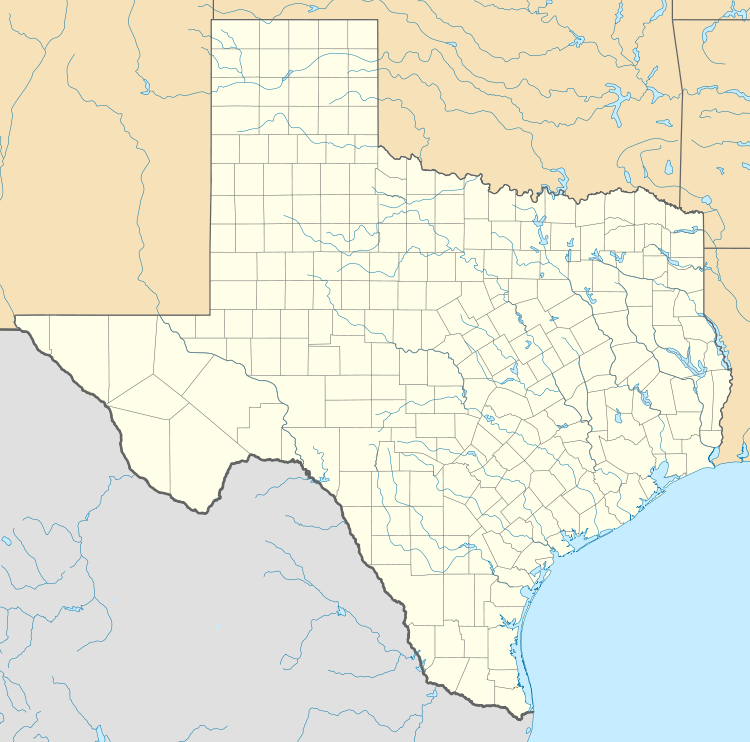Levi Jordan Plantation
| Levi Jordan Plantation | |
|---|---|
 Location of Levi Jordan Plantation in Texas | |
| Location | Brazoria, Texas |
| Coordinates | 28°59′57″N 95°38′54″W / 28.99917°N 95.64833°WCoordinates: 28°59′57″N 95°38′54″W / 28.99917°N 95.64833°W |
| Built | 1848-51[1] |
| Designated | 1967[1] |
| Reference no. | 9570 |
The Levi Jordan Plantation is located on Farm to Market Road 521, 4 miles (6.4 km) southwest of the city of Brazoria, in the county of Brazoria, in the U.S. state of Texas. It was one of the largest sugar and cotton producing plantations in Texas during the mid-19th century. It was designated a Recorded Texas Historic Landmark in 1967.[2]
Levi Jordan
Levi Jordan, born in 1793, was a plantation owner in Union County, Arkansas in 1848. However Jordan was not as successful as he wanted to be. It is for this reason that Jordan and twelve of his slaves traveled to Brazoria County, Texas in 1848. It was here that Jordan purchased 2,222 acres (899 ha) of land from Samuel M. William for $4.00 an acre. Shortly thereafter, Jordan returned to Arkansas to sell his plantation. He also traveled to Louisiana, where Jordan’s daughter Emily, his son-in-law James McNeil, and his grandchildren resided, to sell that land so they could all pack up and move to Texas. Jordan wanted to develop a land that would survive many generations and “outlive” him, according to the oral history of the family. During the time that Jordan was traveling back to Arkansas and Louisiana to tie up loose ends, the twelve slaves that Jordan took to Texas stayed behind in order to get the land ready for development.
The primary cash crops during the first period of the life of the Levi Jordan Plantation were cotton and sugar. In fact, to make even a bigger profit, Jordan built the largest sugar factory in the entire county. Not only did Jordan use this factory to process his sugar cane, but so did the planters surrounding his plantation. The Jordan Plantation was also involved in the trading of slaves. According to records, Jordan imported and raised slaves in order to trade later. After the Civil War, workforce for the production of sugar declined. Furthermore, after the Emancipation in 1865, sugar was produced in very small quantities because the labor needed to man the lands was no longer available. Even though sugar on the Levi Jordan Plantation declined significantly, the cotton production grew due to sharecropping. This is because in 1865, after the Emancipation, Jordan employed many of his former slaves and their descendants as sharecroppers to work and maintain the cotton fields.
Later history
After Jordan’s death in 1873, the land was split between Jordan’s grandsons’ according to his will. His granddaughter Annie McNeil Martin was cut out of the will and was not allowed on the property without the permission of Jordan’s wife, Sara Jordan. He did, however, set aside $5000 for the education of Annie’s sons’ (Jordan’s great grandsons) education.
The site was owned, until 2001, by several site descendants. That year, title was transferred to the State of Texas, and it is now managed by the Texas Historical Commission as the Levi Jordan Plantation State Historic Site. A local advocacy group, the Levi Jordan Plantation Historical Society, was created in the mid-1990s, and its membership includes site descendants and other community members. This group was founded with the assistance of Kenneth L. Brown (the principal archaeological investigator) and Carol McDavid, one of his graduate students at the time. Today Brown and McDavid still work with the society, and Dr. McDavid worked with the local community to create a web site about the archaeology.
The plantation house is being restored, and the site also includes slave quarters. As of November 2015, the site is only open to the public for Saturday tours.[3]
References
- 1 2 "Texas Historic Sites Atlas". Texas Historical Commission. Retrieved 17 March 2013.
- ↑ "Levi Jordan Plantation". Texas Historical Commission. Retrieved 9 February 2012.
- ↑ Levi Jordan Plantation State Historic Site
External links
- Official Levi Jordan Plantation State Historic Site website
- The Levi Jordan Plantation Virtual Museum
- Rootsweb.com: The Levi Jordan Plantation
- Archaeology Magazine: article on the Levi Jordan Plantation